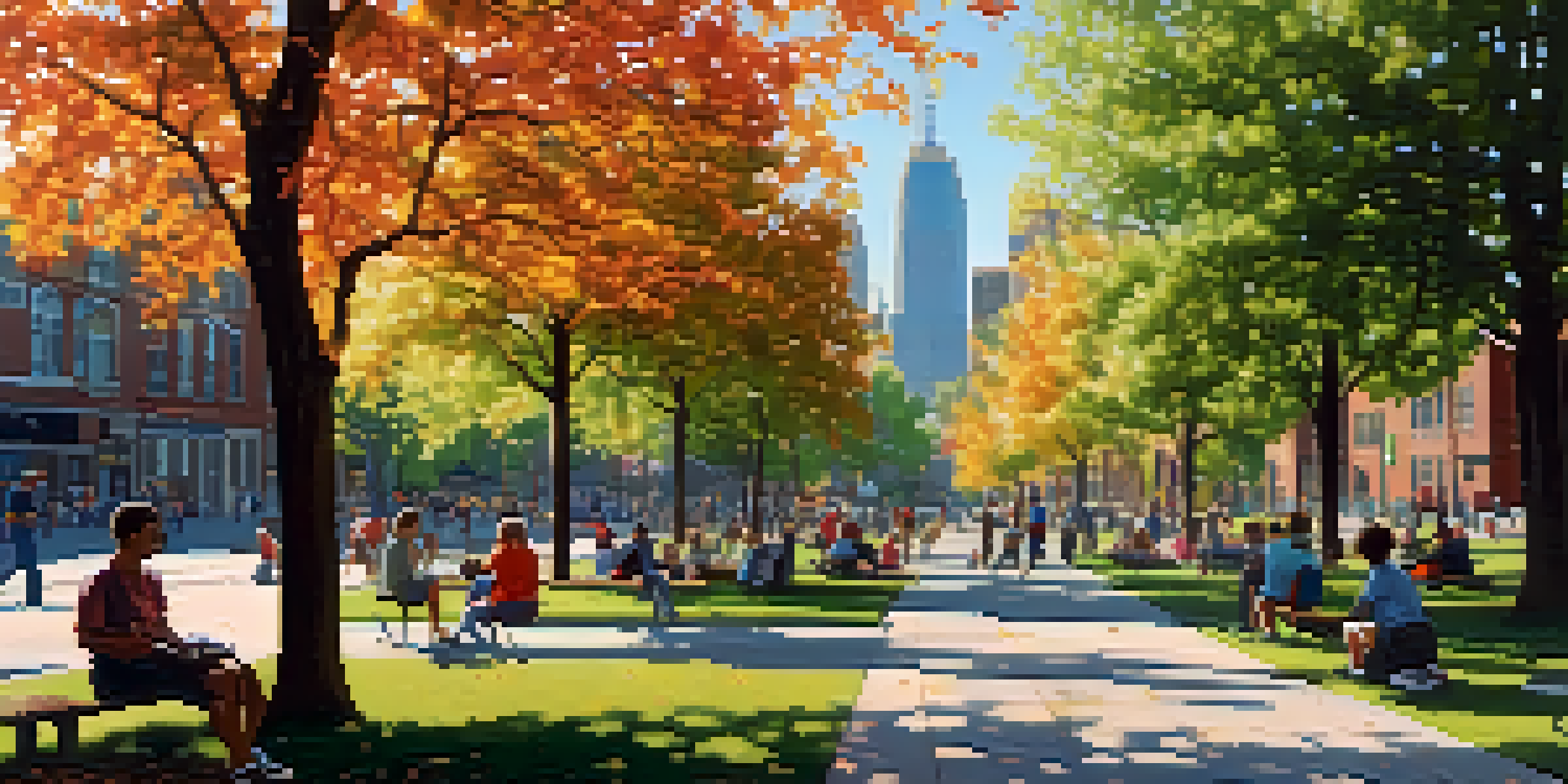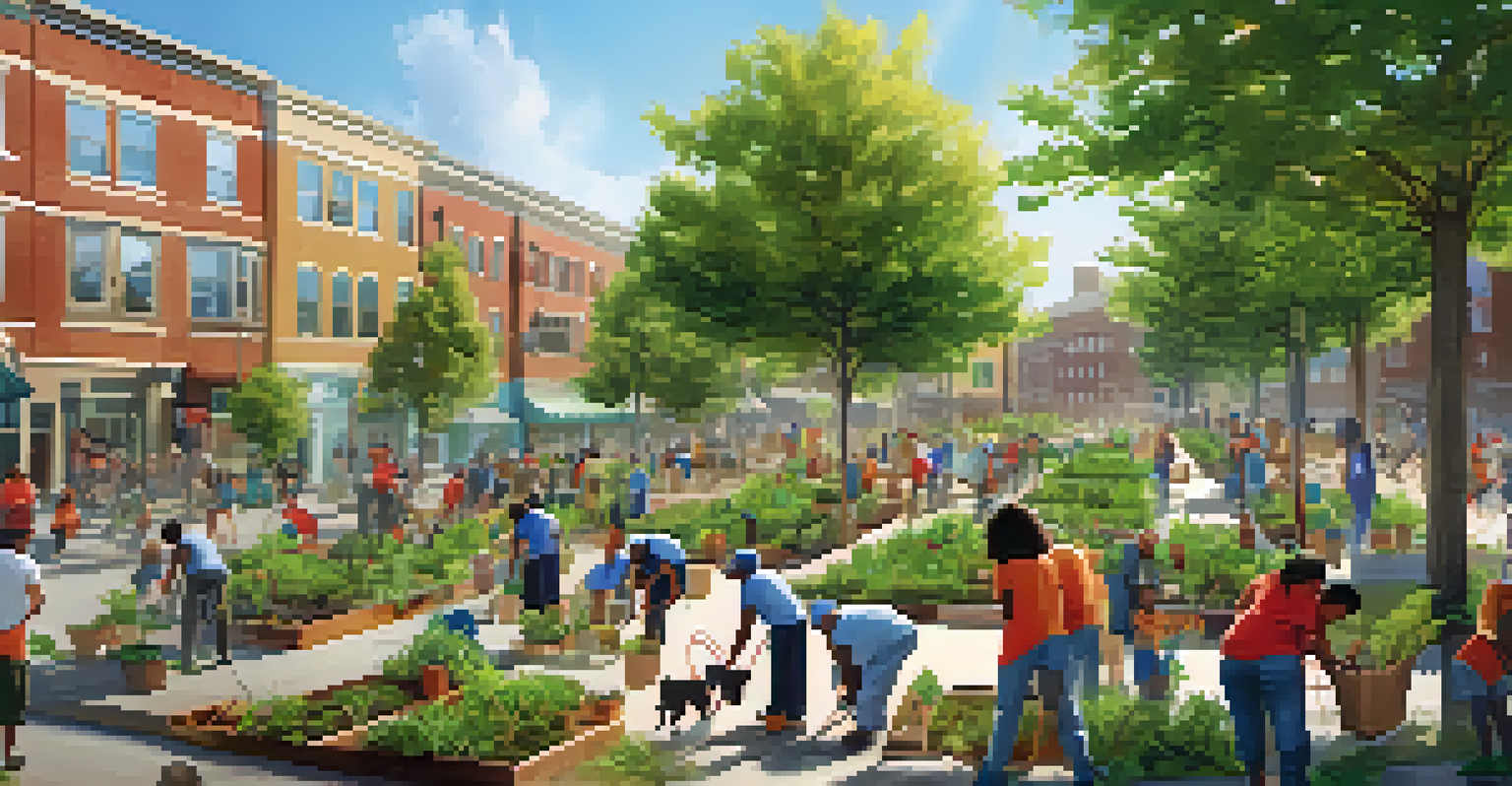The Role of Urban Forestry in Mitigating Air Pollution

Understanding Urban Forestry: More Than Just Trees
Urban forestry involves the management and care of trees in urban areas, focusing on their role in enhancing city environments. These trees provide shade, beautify neighborhoods, and improve local biodiversity. But their most critical function might be their ability to combat air pollution, making cities healthier places to live.
The best time to plant a tree was twenty years ago. The second best time is now.
By planting trees strategically, cities can create green spaces that act as natural air filters. They absorb carbon dioxide and other harmful pollutants, which is vital in densely populated areas where air quality is often compromised. This not only improves the air we breathe but also contributes to overall community well-being.
In essence, urban forestry serves as a bridge between nature and urban life, emphasizing the importance of integrating green spaces into city planning. It encourages a balanced ecosystem, where both humans and wildlife can thrive, leading to a more sustainable urban environment.
How Trees Improve Air Quality: The Science Behind It
Trees play a crucial role in improving air quality through a process known as photosynthesis. During this process, they absorb carbon dioxide and release oxygen, which is essential for life. Moreover, trees capture particulate matter, such as dust and smoke, on their leaves and bark, effectively reducing the number of harmful particles in the air.

Additionally, the transpiration process allows trees to release moisture into the air, creating a cooling effect that can lower temperatures in urban settings. This cooling not only makes outdoor spaces more comfortable but also helps mitigate the formation of ground-level ozone, a harmful air pollutant.
Urban Forestry Enhances Air Quality
Trees play a critical role in improving air quality by absorbing pollutants and releasing oxygen.
The combination of these processes means that the more trees we have in our cities, the better the air quality becomes. By investing in urban forestry, cities can take significant steps toward creating a cleaner, healthier atmosphere for all residents.
Urban Heat Islands: How Trees Combat This Phenomenon
Urban heat islands (UHIs) occur when urban areas experience significantly warmer temperatures than surrounding rural areas due to human activities and infrastructure. This phenomenon not only affects comfort levels but also contributes to higher energy consumption and worsens air quality. Trees are crucial in combating UHIs by providing shade and releasing moisture through transpiration.
Trees are the earth’s endless effort to speak to the listening heaven.
By strategically planting trees, cities can dramatically reduce surface and air temperatures, leading to a cooler urban environment. This cooling effect not only makes outdoor spaces more pleasant but also lowers the demand for air conditioning, resulting in decreased energy use and reduced emissions from power plants.
Ultimately, addressing the urban heat island effect through urban forestry not only improves comfort but also enhances air quality, making cities more livable. As communities recognize the importance of trees in their fight against climate change, urban forestry becomes a key component in their sustainability strategies.
Benefits of Urban Forestry Beyond Air Quality
While the air quality benefits of urban forestry are significant, they are just the tip of the iceberg. Trees provide numerous additional advantages, including enhancing community aesthetics and promoting mental well-being. Studies have shown that green spaces can reduce stress, improve mood, and encourage outdoor activities, all contributing to a healthier lifestyle.
Moreover, urban forests play a vital role in supporting local wildlife, providing habitats and food sources for birds, insects, and other animals. This biodiversity is essential for maintaining ecological balance, even in urban settings, where natural habitats are often limited.
Community Involvement is Key
Engaging residents in urban forestry initiatives fosters a sense of ownership and promotes sustained efforts in maintaining green spaces.
Incorporating urban forestry into city planning not only addresses air pollution but also fosters community cohesion and environmental stewardship, creating a more vibrant urban landscape. The ripple effects of these green initiatives can transform cities into healthier, more sustainable spaces for everyone.
Community Engagement in Urban Forestry Initiatives
Community involvement is crucial in the success of urban forestry initiatives. Engaging local residents in tree planting and care fosters a sense of ownership and responsibility for their environment. This participation can lead to more sustained efforts in maintaining urban forests, ensuring that they thrive and continue to provide benefits.
Additionally, educational programs that emphasize the importance of trees in mitigating air pollution can empower communities to advocate for more green spaces. By raising awareness about the direct connection between trees and air quality, residents are more likely to support policies and initiatives aimed at enhancing urban forestry.
Ultimately, when communities come together to prioritize urban forestry, they not only improve air quality but also strengthen social bonds and promote environmental consciousness. This collective effort is essential for building healthier cities and ensuring a sustainable future.
Policy Measures Supporting Urban Forestry Development
Effective policies are essential for the growth and sustainability of urban forestry programs. Governments can implement regulations that prioritize tree planting and maintenance in urban planning, ensuring that green spaces are integrated into new developments. These policies can also include incentives for businesses that contribute to urban greening initiatives.
Moreover, funding programs and grants can support community-led urban forestry projects, enabling residents to take action in improving their local environments. By providing financial resources, cities can empower communities to enhance their green spaces and actively participate in air quality improvement efforts.
Policies Support Urban Green Spaces
Effective policies are essential for integrating urban forestry into city planning, ensuring the sustainability of green initiatives.
In conclusion, strong policy support is necessary to facilitate urban forestry's role in mitigating air pollution. By prioritizing trees and green spaces in urban planning, governments can create healthier, more sustainable cities for current and future generations.
Measuring the Impact of Urban Forestry on Air Quality
To understand the effectiveness of urban forestry in improving air quality, it's essential to measure its impact accurately. Various tools and methodologies can assess tree canopy cover, pollutant absorption rates, and overall air quality improvements. These measurements can help cities track progress and adjust their urban forestry strategies as needed.
Furthermore, studies have shown that cities with robust urban forestry programs often see significant reductions in airborne pollutants and improved overall air quality. Data collection and analysis can provide valuable insights into the relationship between tree density and air quality, guiding future initiatives.

Ultimately, measuring the impact of urban forestry not only demonstrates its value but also helps to build community support for ongoing green initiatives. By showcasing the tangible benefits of trees in urban areas, cities can foster a culture that prioritizes environmental health and sustainability.